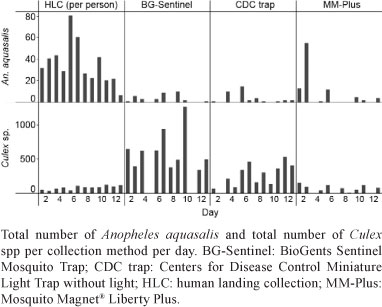Three types of carbon dioxide-baited traps, i.e., the Centers for Disease Control Miniature Light Trap without light, the BioGents (BG) Sentinel Mosquito Trap (BG-Sentinel) and the Mosquito Magnet® Liberty Plus were compared with human landing collections in their efficiency in collecting Anopheles (Nyssorhynchus) aquasalis mosquitoes. Of 13,549 total mosquitoes collected, 1,019 (7.52%) were An. aquasalis. Large numbers of Culex spp were also collected, in particular with the (BG-Sentinel). The majority of An. aquasalis (83.8%) were collected by the human landing collection (HLC). None of the trap catches correlated with HLC in the number of An. aquasalis captured over time. The high efficiency of the HLC method indicates that this malaria vector was anthropophilic at this site, especially as carbon dioxide was insufficiently attractive as stand-alone bait. Traps using carbon dioxide in combination with human odorants may provide better results.
Anopheles aquasalis; BG-Sentinel trap; CDC light trap; Mosquito Magnet Liberty Plus; carbon dioxide


